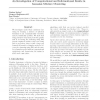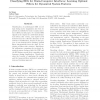ICML
2006
IEEE
16 years 1 months ago
2006
IEEE
93
Voted
ICML
2006
IEEE
16 years 1 months ago
2006
IEEE
We extend Support Vector Machines to input spaces that are sets by ensuring that the classifier is invariant to permutations of subelements within each input. Such permutations in...
ICML
2006
IEEE
16 years 1 months ago
2006
IEEE
In medical diagnosis, doctors often have to order sets of medical tests in sequence in order to make an accurate diagnosis of patient diseases. While doing so they have to make a ...
105
click to vote
ICML
2006
IEEE
16 years 1 months ago
2006
IEEE
Dimensionality reduction is an important pre-processing step for many applications. Linear Discriminant Analysis (LDA) is one of the well known methods for supervised dimensionali...
106
click to vote
ICML
2006
IEEE
16 years 1 months ago
2006
IEEE
We formalize the associative bandit problem framework introduced by Kaelbling as a learning-theory problem. The learning environment is modeled as a k-armed bandit where arm payof...
121
click to vote
ICML
2006
IEEE
16 years 1 months ago
2006
IEEE
There has been a recent, growing interest in classification and link prediction in structured domains. Methods such as conditional random fields and relational Markov networks sup...
104
Voted
ICML
2006
IEEE
16 years 1 months ago
2006
IEEE
For a Markov Decision Process with finite state (size S) and action spaces (size A per state), we propose a new algorithm--Delayed Q-Learning. We prove it is PAC, achieving near o...
110
Voted
ICML
2006
IEEE
16 years 1 months ago
2006
IEEE
We investigate the problem of learning to predict moves in the board game of Go from game records of expert players. In particular, we obtain a probability distribution over legal...
ICML
2006
IEEE
16 years 1 months ago
2006
IEEE
We investigate under what conditions clustering by learning a mixture of spherical Gaussians is (a) computationally tractable; and (b) statistically possible. We show that using p...
88
Voted
ICML
2006
IEEE
16 years 1 months ago
2006
IEEE
Classification of multichannel EEG recordings during motor imagination has been exploited successfully for brain-computer interfaces (BCI). In this paper, we consider EEG signals ...


